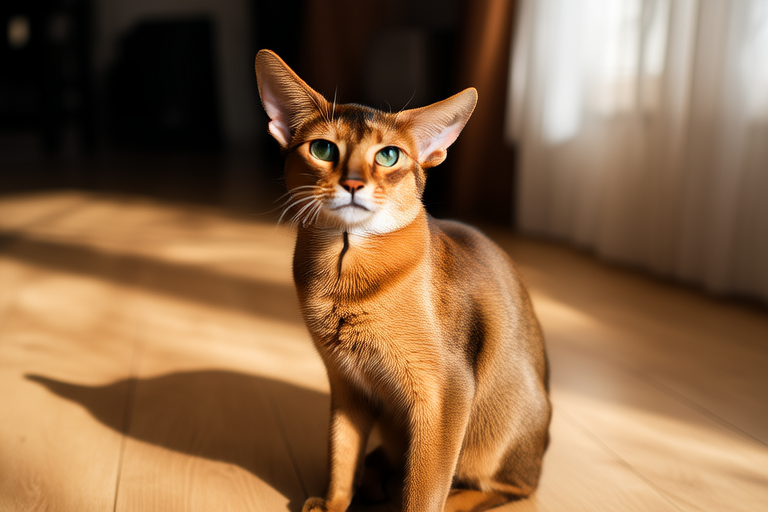Abyssinian Cats: The Ultimate Guide for New Owners
Welcome to the wonderful world of Abyssinian cats! These captivating felines have been enchanting cat lovers for centuries with their striking appearance and playful demeanor. This comprehensive guide will help you understand everything about Abyssinians, from their origin and history to their dietary needs and health concerns. By the end of this article, you’ll be well-equipped to give your new Abyssinian friend the best care possible.
Origin and History
The exact origins of the Abyssinian cat remain somewhat mysterious, but they are believed to have originated in ancient Egypt. According to legend, these cats were worshipped as gods, and their image can be found in Egyptian art. Some historians suggest that the breed may have been brought to England by British soldiers returning from the Abyssinian War in the mid-1800s. The first recorded Abyssinian cat in the United States was imported in 1900, and since then, they’ve become popular pets around the world.
Physical Characteristics
Abyssinians are known for their sleek, muscular bodies and large ears, which make them look like they’re always listening for something exciting. Their coat is short and silky, with a distinctive ticked pattern that gives them a wild appearance. This unique coloring is due to a genetic mutation that causes each hair to have bands of color, resulting in a shimmering effect when light hits their fur. Common colors include ruddy (a warm brown), blue, fawn, and cinnamon.
Temperament and Behavior
Abyssinians are highly intelligent and curious creatures. They love to explore and will often be found investigating every nook and cranny of their environment. Their playful nature makes them great companions for interactive games, and they enjoy climbing and jumping to reach high places. Abyssinians also tend to form strong bonds with their owners, seeking out attention and affection whenever possible. However, they can be quite independent at times, so it’s important to respect their need for alone time.
One of my personal experiences with an Abyssinian cat involved her constant desire to climb onto high shelves. She would sit there, observing everything happening below with keen interest. It became clear that providing her with plenty of vertical spaces, such as cat trees or window perches, helped satisfy her natural instincts.
Dietary Needs
Like all cats, Abyssinians require a balanced diet rich in protein, fats, vitamins, and minerals. High-quality commercial cat food, either wet or dry, formulated specifically for adult cats is usually sufficient. However, if you choose to feed your Abyssinian a homemade diet, consult with a veterinarian or animal nutritionist to ensure proper nutrition. Fresh water should always be available, and avoid feeding them human food as it can lead to digestive problems or other health issues.
Grooming Requirements
Despite their short coats, Abyssinians still require regular grooming to maintain their luxurious fur. Brushing them once or twice a week helps remove loose hairs and prevents matting. Bathing is generally unnecessary unless they get particularly dirty. Regular nail trimming and dental care are also important aspects of their grooming routine.
Common Health Issues
Abyssinians are generally healthy cats, but they are prone to certain genetic conditions. Progressive retinal atrophy (PRA) is a degenerative eye disease that can lead to blindness. Periodic eye examinations by a veterinarian are recommended to catch any signs early. Another condition to watch for is renal amyloidosis, a disorder where abnormal proteins accumulate in the kidneys, potentially leading to kidney failure. Regular check-ups and monitoring of their overall health can help prevent complications.
Exercise and Play Recommendations
Abyssinians are very active and energetic cats, requiring ample opportunities for exercise and play. Interactive toys such as feather wands, laser pointers, and puzzle feeders can keep them engaged and stimulated mentally. Providing scratching posts, climbing structures, and other enrichment items will encourage physical activity and help satisfy their natural hunting instincts. Daily play sessions are essential for maintaining their physical and mental well-being.
Training Tips
Training an Abyssinian cat can be both rewarding and challenging. Positive reinforcement techniques, such as offering treats or praise, work best for encouraging desired behaviors. Clicker training is another effective method that involves using a clicker to mark good behavior followed by a reward. Teaching basic commands like ‘come’ or ‘sit’ can strengthen the bond between you and your cat while making everyday tasks easier.
Advice on Integrating Them Into a New Home
Introducing a new Abyssinian kitten or adult cat into your home requires patience and careful planning. Start by setting up a quiet room where your new companion can feel safe and secure during the initial adjustment period. Gradually introduce them to other family members and pets, allowing supervised interactions until everyone feels comfortable. Establishing routines for feeding, playing, and grooming helps create a sense of stability and predictability for your Abyssinian.
In conclusion, Abyssinian cats offer a unique blend of beauty, intelligence, and personality that makes them truly special companions. By understanding their specific needs and providing proper care, you can ensure many years of joy and companionship with your Abyssinian friend. Remember that each cat is an individual, so take the time to learn what makes yours happiest and healthiest.
